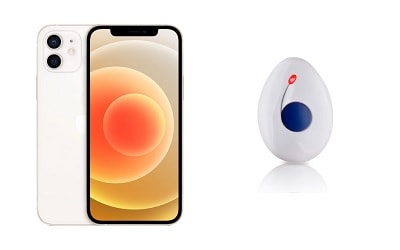Last Updated on July 5, 2022
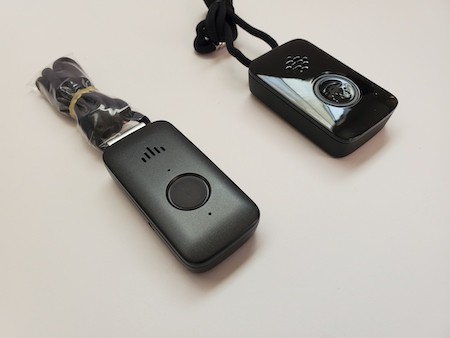
Cellular 4G LTE medical alert pendants, connects through Verizon or AT&T
When looking into medical alert systems, a common question is whether the medical alert will work with a cell phone. By now, speaking in 2022, a medical alert or “life alert” button that connects through a cellular network has become commonplace.
As a matter of fact, the cellular connection is built into the mobile alert button or base unit directly. It’s not necessary, nor will you be able, to sync the medical alert button or device with your cell phone or cell phone plan.
Updated recommended list 2022 (click to see):
Medical Alert Systems That Work With Cell Phone Networks
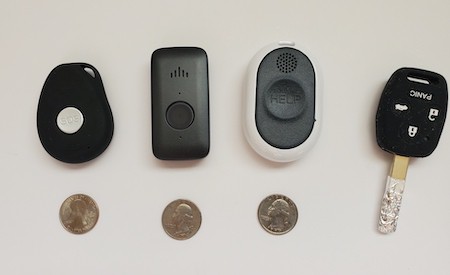
(skip to more info)
The medical alert company will set-up the cellular connection and they are responsible for the ongoing fees to the cellular phone service providers. This is done at an aggregate level. Individual medical alert cellular subscribers will then pay the medical alert company directly.
All a customer needs to do is to select a good cellular medical alert button or device and then start a subscription with the medical alert monitoring company.
Thus, the medical alert will not be connecting through a landline, personal cell phone, or cell phone plan at all. Below are examples of top-tier cellular medical alert buttons to look into.
Medical Alert Systems That Work With Cell Phone Networks
These cellular medical alert systems are ideal for seniors and other customers who want an on-the-go system that works both in and out of their homes. They do not require subscribers to have a cell phone, wifi or the internet in order to work.
Medical Alert Cellular Buttons/ Devices
Introduced in Oct 2021, the LifeFone VIPx button pendant is based on the lightest and most streamlined design available for a cellular voice-in-pendant medical alert. They connect through either Verizon or AT&T networks.
In the video below, we demonstrate how the VIPx device connected through Verizon’s wireless network. We did not need to link it through a separate cell phone or cellular plan subscription.
Questions? Call toll-free 1-877-352-1292 or visit LifeFone’s Official Website
This medical alert pendant comes with a long battery life of up to 16 days on a full charge. Its battery life outperforms similar medical alert pendants that typically will last up to 3 to 5 days before power is fully drained.
The LifeFone VIPx works both in and out of the home; and has GPS and advanced location tracking technologies to pinpoint your location. This is useful in case help needs to be dispatched.
There are also options to add automatic fall detection or a VIPx Caregiver App that will share information such as the subscriber’s daily first step motion, GPS location, emergency button presses, battery level and other information with caregivers.
Unfortunately, if you add on the Caregiver App, it’s an additional $8 a month. It will also decrease the battery level to a 5-day max, which is still better-than-average but not as long as up to 2 weeks if the app is not turned on.
In terms of features and design, this product ranks top-tier without being over-complicated for seniors and their family. LifeFone has decades of industry experience behind it, and is mindful about providing good features and services to their customers.
In terms of cost, the VIPx’s monthly fees are competitively priced. The company does not require customers to purchase their devices upfront, nor do they require a minimum term of commitment. To learn more, call 1-877-352-1292 or visit LifeFone’s website here.
More Medical Alert Pendants (Cellular-based)
The Bay Alarm Medical Mobile GPS pendant is a stylish and lightweight mobile medical alert.
In the video below, we successfully connected to Bay Alarm Medical‘s mobile medical alert device through AT&T’s cellular LTE network. If you play the video, you will see that the device connected on its own. We did not link the device to a separate cell phone or cell phone plan line. The device has its own SIM card.
Questions? Call toll-free 1-855-397-9964 or visit Bay Alarm Medical’s website
This Bay Alarm Medical mobile medical alert device operated somewhat like a small emergency alert cell phone (with limitations) with its own SIM card and two-way speakerphone. We pushed on the help button and spoke with a trained Bay Alarm Medical monitoring agent.
Our service subscription included AT&T 4G LTE connectivity and a caregiver app for sharing GPS location. Compared to other cell-phone-like on-the-go medical alert devices, it is less costly. The Bay Alarm Medical mobile medical device is best recommended for people seeking a stylish device that works well and comes with modern, easy account management tools, and good value pricing.
Overall, we would still choose the LifeFone VIPx (above) over this device because the VIPx is physically more comfortable to wear (smaller and lighter), has a stronger backup battery life (up to 16 days) and a faster response time (32 seconds vs 48 seconds).

Cellular Medical Alert for In-Home Use
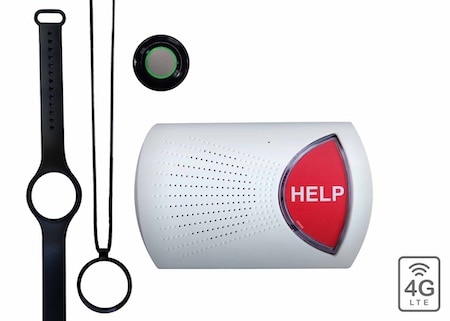
Call connection via cellular phone network
Questions? Call toll-free 1-855-397-9964 or visit Bay Alarm Medical’s website
This is a no-landline-needed alternative to a traditional landline Life Alert system.
The in-home button is ultra-light (only 0.6 oz vs. 2.0 oz average for an on-the-go button) as it does not contain a speaker and microphone. Its lightness makes it more convenient to wear throughout the day. We found this option the most comfortable to wear with a lanyard compared to the above two on-the-go pendants.
If you mostly require in-home medical alert monitoring, the Bay Alarm Medical system is a good system to consider because it provides that without tying up your cell phone or landline. Neither a home phone line or cell phone is needed as the base unit contains its own SIM card and cellular connection.
We were able to easily set-up this Bay Alarm system by plugging it into power and turning the base unit on. Next, we pushed on the necklace help button to make a test call. It then signaled the base speaker unit to call the monitoring center through an AT&T cellular connection. Here is a video demonstration of the entire process:
Essentially, it’s plug-and-play; it only requires a connection to a power outlet to work.
The best part about this Bay Alarm Medical in-home cellular system is that it performed well when tested. In our testing, it provided a good combination of fast response time (40 seconds on average) and long backup battery life (25 hours after unplugging from power source), providing comparatively better performance than units from other popular brands.
For example, with Medical Guardian’s Home 2.0, the performance test results were 84 seconds on average for call response time and 17 hours of backup battery life. With LifeFone’s In-Home Cellular, the performance numbers were 47 seconds for call response time and under 1/2 hour of backup battery life respectively. Note that each brand has different products, and each product will perform differently.
Questions on Bay Alarm Medical? Call toll-free 1-855-397-9964 (click to call) to Request a Quote.
Smartwatch with Alert Call Button
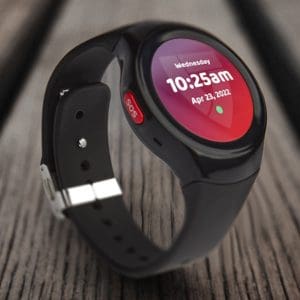
If you prefer a more modern format, consider an emergency alert smartwatch. Here, the usual medical alert necklace button has been given a design makeover.
The watch’s phone capabilities are built-in. The watch houses a SIM card and speakerphone for calling into the emergency monitoring center and speaking with the operator. The device works independently of a smartphone and does not require internet access or wifi to work. To learn more, contact
Medical Guardian at 1-800-311-6142
Why Medical Alert Systems?
Simple One-Click Operation
Medical alert buttons and devices are designed to be really simple to use in case of emergencies. All the senior customer needs to do is click on the button. Most medical alert buttons are specially designed to be worn around the neck, on the wrist or with a belt clip.
The user experience is easier than whipping out the mobile phone, waking it from sleep mode, and then dialing 911, or a family member.
Monitoring Help Available
The availability of 24/7 monitoring help dedicated to working with seniors and customers with disabilities can make a difference to the speed at which the customer can access help. Their son or daughter may not be able to pick up their phone call right at the moment, and they may hesitate to call 911. The monitoring operator can help the senior with calling their doctor, daughter/son or caregiver, without needing to involve 911. Here is yet another example of how having monitoring help can make a difference.
No Frequent Charging Needed (In-Home Systems)
Cell phones require more frequent charging when compared to traditional in-home medical alert buttons where the batteries last for years without needing to be changed. Keep in mind that mobile medical alert devices like some of the examples above will require frequent charging as well.
Small Lightweight Button
Unlike small lightweight medical alert buttons, cell phones are more bulky. Understandably, the senior user may not feel inclined to carry their cell phones around with them all the time when in their own home. But if a fall happens unexpectedly, they can’t dial out for help.
Use Around Shower Areas
A lot of medical alert buttons are waterproof and can be worn in showers and baths where its easier to slip and fall. Cell phones are not waterproof and we tend to keep them away from the shower in case they get wet. Check out this video where we tested a medical alert button in a shower (last 1/3 of video).
Integrated Fall Alert Detection Option
Medical alert buttons that come with built-in automatic fall alert detection are common and used by many. This feature is integrated into the medical alert system, so that emergency calls are triggered when a fall has been detected (not 100% accurate but works).
Although there are more and more smartphone Apps featuring automatic fall detection, most are not that simple to use. They depend on the smartphone’s operating system, and may require additional manual manipulation. Many of these Apps do not dial out to monitoring centers, something that many dedicated medical alert buttons have been preset to do.
Can a Cell Phone Replace a Medical Alert?
Since cell phones can be used to notify 911 or an emergency contact when an emergency occurs, why get a new device? We covered some reasons for having a medical alert, such as the ease and support it provides. However, there are some reasons for relying on a cell phone, such as:
No Extra Device To Carry Around
Most seniors these days have a cell phone. They already know how to operate their cell phones, so there is nothing new to get used to. Most people also have their cellular phones with them most of the time, whether at home or out.
Whether or not to rely on a cell phone or to go with a medical alert system depends on you or your parent’s level of comfort with the benefits and risks that these options present.
A cell phone is one way to reach out for help, but it may not be as simple and reliable as a medical alert system that is designed and actively supported for the purpose of handling emergency calls.
Savings
If someone is already paying for their cell phone, there are no additional costs required. Medical alert buttons will mean extra costs.
Not Tethered to Your Home
Cell phones are mobile by nature, and they can be used both in and out of the home. The traditional medical alert button is tethered to a home base console for it to work. However, newer mobile medical alert buttons do offer the benefit of being able to operate both in and out of the home.
As described above, there are newer mobile medical alerts that work like emergency cell phones connecting people to a monitoring center.
“Medical Alert” Cell Phone Apps
Smartphones these days come with different medical and emergency alert apps that make it easy to send an alert out during emergencies. They are a great supplement to the usual calling or texting mechanism of cell phones.
In comparison, using an app will not be as easy as pushing a physical button, especially when we are caught in a stressful situation. It will a bit of composure to unlock the phone screen and pull up the app.
Still, there are useful apps like the LifeFone Mobile Alert App that will connect subscribers to their emergency alert monitoring center. By pushing on the virtual help button, LifeFone’s care agents will come on the line to assist.
Another example is the Red Panic Button is an app that has a big red panic button seniors can touch to send a text an alert out to a group of contacts. It will even append the phone’s GPS location to the alert message. We have a post that reviews the list of top 5 features to consider when choosing a mobile alert app.
Related: Medical Alert Systems Reviews
Summary
Newer medical alert systems work through a cellular network. Unlike more traditional medical alert systems that rely on a home landline, mobile cellular systems work both in and out of the home.
Similar to a phone device, a mobile medical alert has a SIM card and speakerphone fitted inside. Most of us want a quick and reliable way to reach out for help just in case. With a mobile medical alert button, subscribers are a button push away from connecting with professional assistance when emergencies occur, whether at home or on-the-go.
More examples of cellular medical alert systems >
- Bay Alarm Medical In-Home Cellular Response Speed 46% Faster in 2023 - July 5, 2023
- Medical Alert Systems For Landlines - November 20, 2022
- The Truth About Long-Range Medical Alert Systems - May 1, 2022

